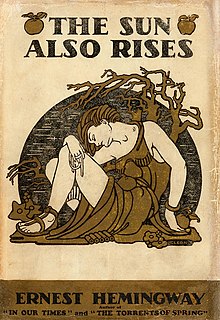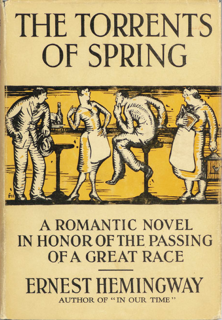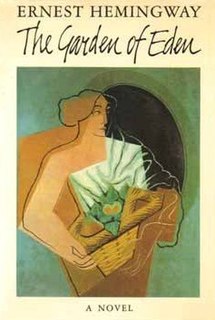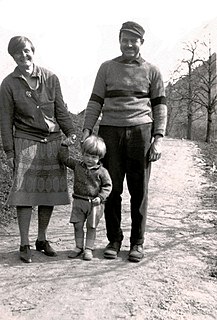
"Soldier's Home" is a short story by Ernest Hemingway. It was included in the 1925 Contact Collection of Contemporary Writers and published by Boni & Liveright in Hemingway's 1925 New York collection short stories, In Our Time . [1]

"Soldier's Home" is a short story by Ernest Hemingway. It was included in the 1925 Contact Collection of Contemporary Writers and published by Boni & Liveright in Hemingway's 1925 New York collection short stories, In Our Time . [1]
The story's protagonist is Harold Krebs, a young man who is unhappy after he returns home from serving in World War I.
The story begins with a very brief background of Krebs' life. Before the war, he attended a Methodist college in Kansas where he was part of a fraternity. In 1917, Krebs enlisted in the Marines and did not return to the United States from Germany until 1919.
By the time of his return to his home state of Oklahoma, the town has already given the returned soldiers a big, elaborate welcoming; Krebs’ return seems late and irrelevant as the war had already been over for some time. Krebs was involved in the battles at Belleau Wood, Soissons, the Champagne, St. Mihiel, and the Argonne Forest. At first, Krebs did not want to share his experiences, but as time progressed at home, he wanted to talk about the war but no one wanted to listen. Krebs lies about his wartime accounts in order to gain an audience, though he does not want a ton.
By late summer, Krebs is doing typical things: he sleeps in late, reads books, plays pool and his clarinet, goes for walks and reads. He has no interest getting a girlfriend. He just looks at girls because they are pretty, but he does not want to have to work to get one.
About a month after his return, his mother requests that he come downstairs to eat breakfast. While Krebs is eating breakfast he reads the newspaper and talks to Helen. He then agrees that he loves his mother, but without much emotion.
The conversation ends as his mother comes back into the room and asks to speak with Krebs. His mother says God cannot have any idle hands in his Kingdom. Krebs replies that he is not in His Kingdom. He then feels embarrassed for saying that. Krebs’ mother then tells him that she understands how he feels, and that she is worried about him. She says that her father told her about his own service in the Civil War and that she has been praying for Krebs because she knows how he must feel. She then asks if Krebs loves her, and he says no; she cries. Krebs states that he doesn't love anybody. Krebs then realizes that he won't be able to make her understand and saying that will only hurt her. He says that he did not mean what he said but he does not love anyone anymore. Krebs begs her to believe that he did not mean it and so she prays for him.
The story concludes with Krebs plotting to leave his hometown and get a job in Kansas City.
In the 1920s, Hemingway was inspired by Ezra Pound's writings and applied the poet's principles of imagism to his own early work. [2] Hemingway's short stories from the 1920s adhere to Pound's tight definition of imagism; [3] biographer Carlos Baker writes that in his short stories Hemingway tried to learn how to "get the most from the least, [to] prune language, [to] multiply intensities, [to] tell nothing but the truth in a way that allowed for telling more than the truth". [4] Hemingway adapted this style into a technique he called his iceberg theory: as Baker describes it, the hard facts float above water while the supporting structure, including the symbolism, operates out of sight. [4]
The story takes place in Krebs’ hometown in Oklahoma around the early 1920s after World War I. The town is the same, while Krebs himself has changed. His home is where he reflects on things that have changed him, like watching the girls and not wanting to get one, and telling his mother he does not love her.
There are many symbols used throughout the story. Harold Krebs' name itself is a symbol. Harold "is an old English name meaning army power or army ruler." Krebs also had German ties to the word crab, which is a metaphor for Krebs’ crab-like shell he has obtained from his experiences (Ullrich What's).
The way that Harold has changed represents how America has been changed from the war. His values were changed now, like how America has been challenged from changing values to more modern times (Smelstor Soldier's).
Krebs’ home plays a large role in the story as well. On his porch, Krebs sits and observes the women of his town, much like how trenches in warfare allow a vantage point to observe enemy's movements. Here, Krebs' home is represented in such a way that can be related to Krebs’ wartime experiences.
The map is another symbol. Krebs is reading a book about the war but he wished it had many more detailed maps. This symbolizes how now he is searching for direction in his own life, how he wishes his life would be mapped out. For the past two years he has been in the army listening to directions, now he is free and does not know what to do.
A final symbol is the photograph in the beginning of the story. It describes Krebs and his fraternity brothers all of whom were wearing exactly the same thing. This shows "the conformist mentality of prewar, midwestern America" (Smelstor What's).
Soldier's Home was adapted to a PBS television movie in 1977.

Ernest Miller Hemingway was an American novelist, short-story writer, and journalist. His economical and understated style—which he termed the iceberg theory—had a strong influence on 20th-century fiction, while his adventurous lifestyle and public image brought him admiration from later generations. Hemingway produced most of his work between the mid-1920s and the mid-1950s, and he was awarded the 1954 Nobel Prize in Literature. He published seven novels, six short-story collections, and two nonfiction works. Three of his novels, four short-story collections, and three nonfiction works were published posthumously. Many of his works are considered classics of American literature.

The Sun Also Rises is a 1926 novel by American writer Ernest Hemingway, his first, that portrays American and British expatriates who travel from Paris to the Festival of San Fermín in Pamplona to watch the running of the bulls and the bullfights. An early and enduring modernist novel, it received mixed reviews upon publication. However, Hemingway biographer Jeffrey Meyers writes that it is now "recognized as Hemingway's greatest work", and Hemingway scholar Linda Wagner-Martin calls it his most important novel. The novel was published in the United States in October 1926 by Scribner's. A year later, Jonathan Cape published the novel in London under the title Fiesta. It remains in print.

"The Snows of Kilimanjaro" is a short story by American author Ernest Hemingway first published in August, 1936, in Esquire magazine. It was republished in The Fifth Column and the First Forty-Nine Stories in 1938, The Snows of Kilimanjaro and Other Stories in 1961, and is included in The Complete Short Stories of Ernest Hemingway: The Finca Vigía Edition (1987).

The Torrents of Spring is a novella written by Ernest Hemingway, published in 1926. Subtitled "A Romantic Novel in Honor of the Passing of a Great Race", Hemingway used the work as a spoof of the world of writers. It is Hemingway's first long work and was written as a parody of Sherwood Anderson's Dark Laughter.

The Garden of Eden is the second posthumously released novel of Ernest Hemingway, published in 1986. Hemingway started the novel in 1946 and worked on the manuscript for the next 15 years, during which time he also wrote The Old Man and the Sea, The Dangerous Summer, A Moveable Feast, and Islands in the Stream.

In Our Time is the title of Ernest Hemingway's first collection of short stories, published in 1925 by Boni & Liveright, New York, and of a collection of vignettes published in 1924 in France titled in our time. Its title is derived from the English Book of Common Prayer, "Give peace in our time, O Lord".

Across the River and Into the Trees is a novel by American writer Ernest Hemingway, published by Charles Scribner's Sons in 1950, after first being serialized in Cosmopolitan magazine earlier that year. The title is derived from the last words of U.S. Civil War Confederate General Thomas J. "Stonewall" Jackson: “Let us cross over the river and rest under the shade of the trees.”

Agnes Hannah von Kurowsky Stanfield was an American nurse who inspired the character "Catherine Barkley" in Ernest Hemingway's 1929 novel A Farewell to Arms.

Elizabeth Hadley Richardson was the first wife of American author Ernest Hemingway. The two married in 1921 after a courtship of less than a year, and moved to Paris within months of being married. In Paris, Hemingway pursued a writing career, and through him Hadley met other expatriate American and British writers.

The iceberg theory or theory of omission is a writing technique coined by American writer Ernest Hemingway. As a young journalist, Hemingway had to focus his newspaper reports on immediate events, with very little context or interpretation. When he became a writer of short stories, he retained this minimalistic style, focusing on surface elements without explicitly discussing underlying themes. Hemingway believed the deeper meaning of a story should not be evident on the surface, but should shine through implicitly.

"Big Two-Hearted River" is a two-part short story written by American author Ernest Hemingway, published in the 1925 Boni & Liveright edition of In Our Time, the first American volume of Hemingway's short stories. It features a single protagonist, Hemingway's recurrent autobiographical character Nick Adams, whose speaking voice is heard just three times. The story explores the destructive qualities of war which is countered by the healing and regenerative powers of nature. When it was published, critics praised Hemingway's sparse writing style and it became an important work in his canon.

"Cat in the Rain" is a short story by American author Ernest Hemingway (1899-1961), first published by Richard Hadley of Boni & Liveright in 1925 in the short story collection In Our Time. The story is about an American man and wife on vacation in Italy. Critical attention focuses chiefly on its autobiographical elements and on Hemingway's "theory of omission".

"Indian Camp" is a short story written by Ernest Hemingway. The story was first published in 1924 in Ford Madox Ford's literary magazine Transatlantic Review in Paris and republished by Boni & Liveright in Hemingway's first American volume of short stories In Our Time in 1925. Hemingway's semi-autobiographical character Nick Adams—a child in this story—makes his first appearance in "Indian Camp", told from his point of view.

"A Very Short Story" is a short story written by Ernest Hemingway. It was first published as a vignette, or chapter, in the 1924 Paris edition titled In Our Time, and later rewritten and added to Hemingway's first American short story collection In Our Time, published by Boni & Liveright in 1925.

"The Doctor and the Doctor's Wife" is a short story by Ernest Hemingway, published in the 1925 New York edition of In Our Time, by Boni & Liveright. The story is the second in the collection to feature Nick Adams, Hemingway’s autobiographical alter ego. "The Doctor and the Doctor's Wife" follows "Indian Camp" in the collection, includes elements of the same style and themes, yet is written in counterpoint to the first story.
Soldier's Home is a 1977 American short film adaptation of the 1925 short story of the same name by Ernest Hemingway which was originally broadcast as part of The American Short Story series on PBS on April 25, 1977. It was directed by Robert Young, adapted by Robert Geller and starred Richard Backus and Nancy Marchand. The musical score is by Dick Hyman.

"Cross Country Snow" is a short story written by Ernest Hemingway. The story was first published in 1924 in Ford Madox Ford's literary magazine Transatlantic Review in Paris and republished by Boni & Liveright in Hemingway's first American volume of short stories In Our Time in 1925. The story features Hemingway's recurrent autobiographical character Nick Adams and explores the regenerative powers of nature and the joy of skiing.
On Writing is a story fragment written by Ernest Hemingway which he omitted from the end of his short story, "Big Two-Hearted River", when it was published in 1925 in In Our Time. It was then published after Hemingway's death in the 1972 collection The Nick Adams Stories.

Grace Ernestine Hall Hemingway was an American opera singer, music teacher, and painter. She was Ernest Hemingway's mother.
Today is Friday is a short, one act play by Ernest Hemingway (1899-1961). The play was first published in pamphlet form in 1926 but became more widely known through its subsequent publication in Hemingway's 1927 short story collection, Men Without Women. The play is a representation of the aftermath of the crucifixion of Jesus, in the form of a conversation between three Roman Soldiers and a Hebrew bartender. It is one of the few dramatic works written by Hemingway. The play was recently performed on Saturday April 3, 2021 in Clifton Springs, N.Y nearly 95 years after Ernest Hemingway wrote it. The Wellspring Community Theater, under the direction of Tommy Smith from Warsaw, N.Y. performed the play during the Wellspring Church's Resurrection Celebration under the guidance and leadership of Pastor Dr. Les Moore. TODAY IS FRIDAY was included as Scene 1 of the group's 4 scene music and dance production entitled FRIDAY TO SUNDAY. It was also performed Easter weekend 2002 at Crossroads Bible Church in Bellevue, WA.